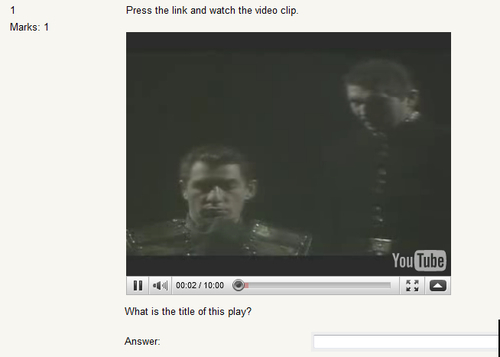Video can be an extremely useful tool for listening tests. Conversations between characters, monologues, and lectures can all be used for listening comprehension and listening for details testing. There are a few ways to add video to your listening tests. We can embed videos, link to them, or upload them to our course.
The biggest sites today, sites like YouTube, Dailymotion, and Hulu, offer a variety of videos and categories that can be used for classes and testing purposes. Since YouTube is the biggest and offers the largest variety of videos, in multiple languages, we will use it as our main source for video.
The first option for adding video is using a link. First, we will look at simply copying and pasting a link into the question text. Then, we will look at adding a link to a video by using the same method we used for adding a link to the MP3 files we just saw.
The first thing we need to do is decide what the listening task will be. We have decided that we want our students to be able to identify a play by watching and listening to a famous soliloquy. We will use the 'Tomorrow, and tomorrow, and tomorrow' one once again.
Our next step is to find a video we want to use. We want to have a large selection available to choose from, so we will use YouTube. We do a simple search in YouTube and we quickly locate several videos that look useful. After watching several, we select the one we want to use and now we need to create our question.
We will be using a Short Answer question format in Quiz, so I open the Question bank in the Quiz I am working with and select Short Answer under Add a New Question. I enter in the text of the question, enter the answer, and feedback.
Next, we copy and paste the link from the YouTube address bar and paste it in the textbox. This will directly link the question to the video from the site and students will see what they are supposed to view in the question.
Following these instructions we see something like the next screenshot:

The same effect can be accomplished by using the Insert a Web Link button. We need to have some text to create the link. So we can either, as I usually do, insert an 'X' or some other text, then highlight it and click on the Insert a Web Link button, which will bring up the Insert Web Link menu. Since we have already copied the address for the video we want to view, we simply paste the address from the YouTube site into the URL textbox. This will give us the same question format as the previous image, but instead of a link to the video as the Title, we have the option to title it whatever we'd like. This can be useful especially if the site name gives students information about the video they should not have, for example, if the site we used for the video was titled Shakespeare-Macbeth.org or something similar.
Embedding video is a little more complex but still easy to do. It is like linking, but the user will access the video from inside Moodle. This time we will use a simple True/False item to show how this works.
Assuming that we already have a question we want to use, the first thing that we need to do is find a video we want to use. We will use the same Macbeth video as we used for the linking explanation.
Looking at the video's page on YouTube, we can see directly under the video a button called<Embed>. Clicking on this button will open a window below with several options including colors, borders, and size. We will not worry about these now, but feel free to play around with the video settings if you want. We are only going to look at the most important thing here, the HTML snippet. The HTML snippet, which should already be highlighted for you, is really all we need from here. We will simply copy the snippet and go back to the question. Now we can embed the video in the question.
In the question, we are going to ask the students to watch the video, then identify whether or not the scene is from Macbeth. We write our question text. When this is finished, we click on the Toggle HTML Source button and paste the address where we want it. The before and after screenshots that show the changes made when embedding the video are as follows:


This will produce a question that looks identical to the linked videos described previously, except it will be embedded and not a link. When finished, click on the Save button at the bottom of the page.
